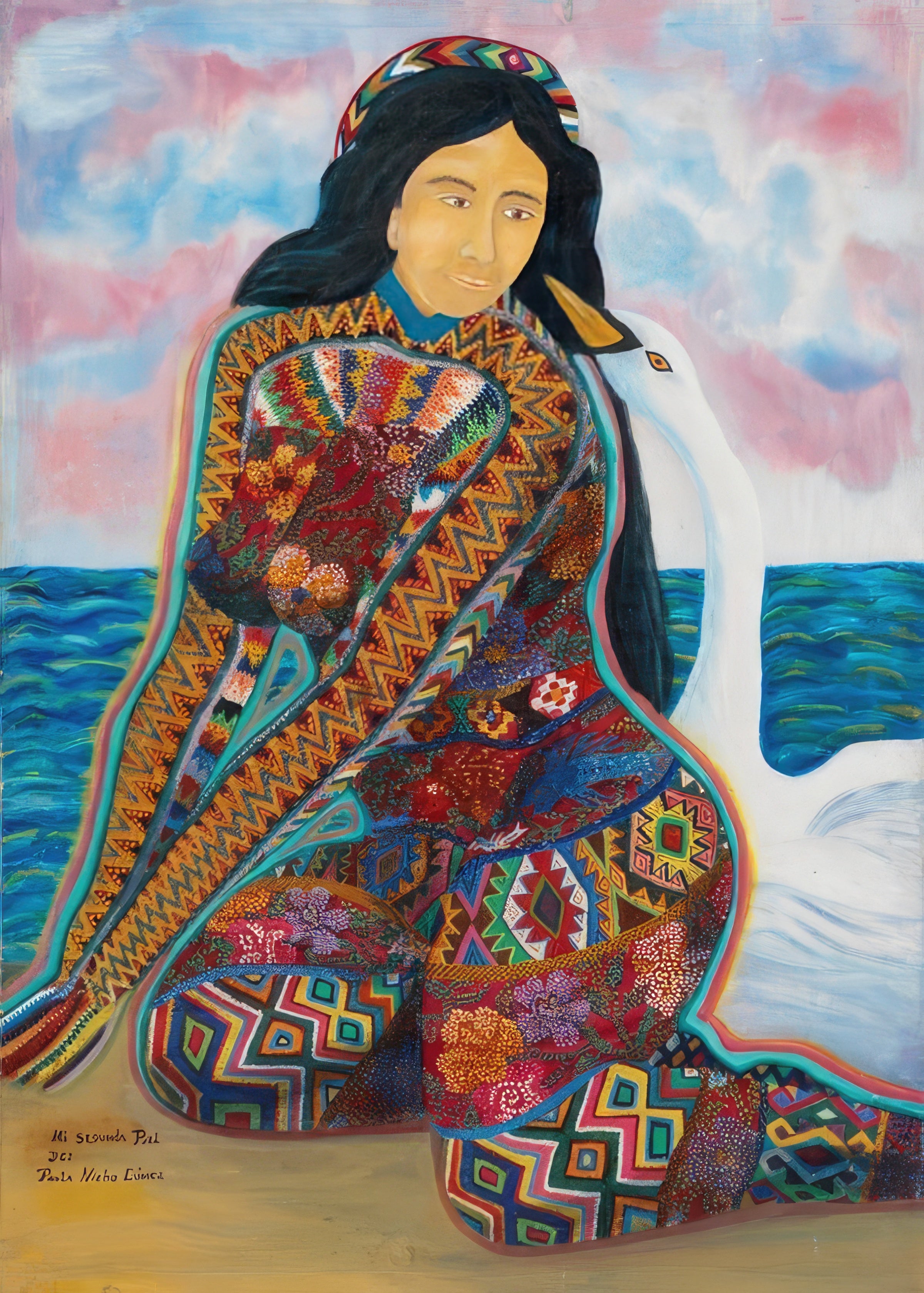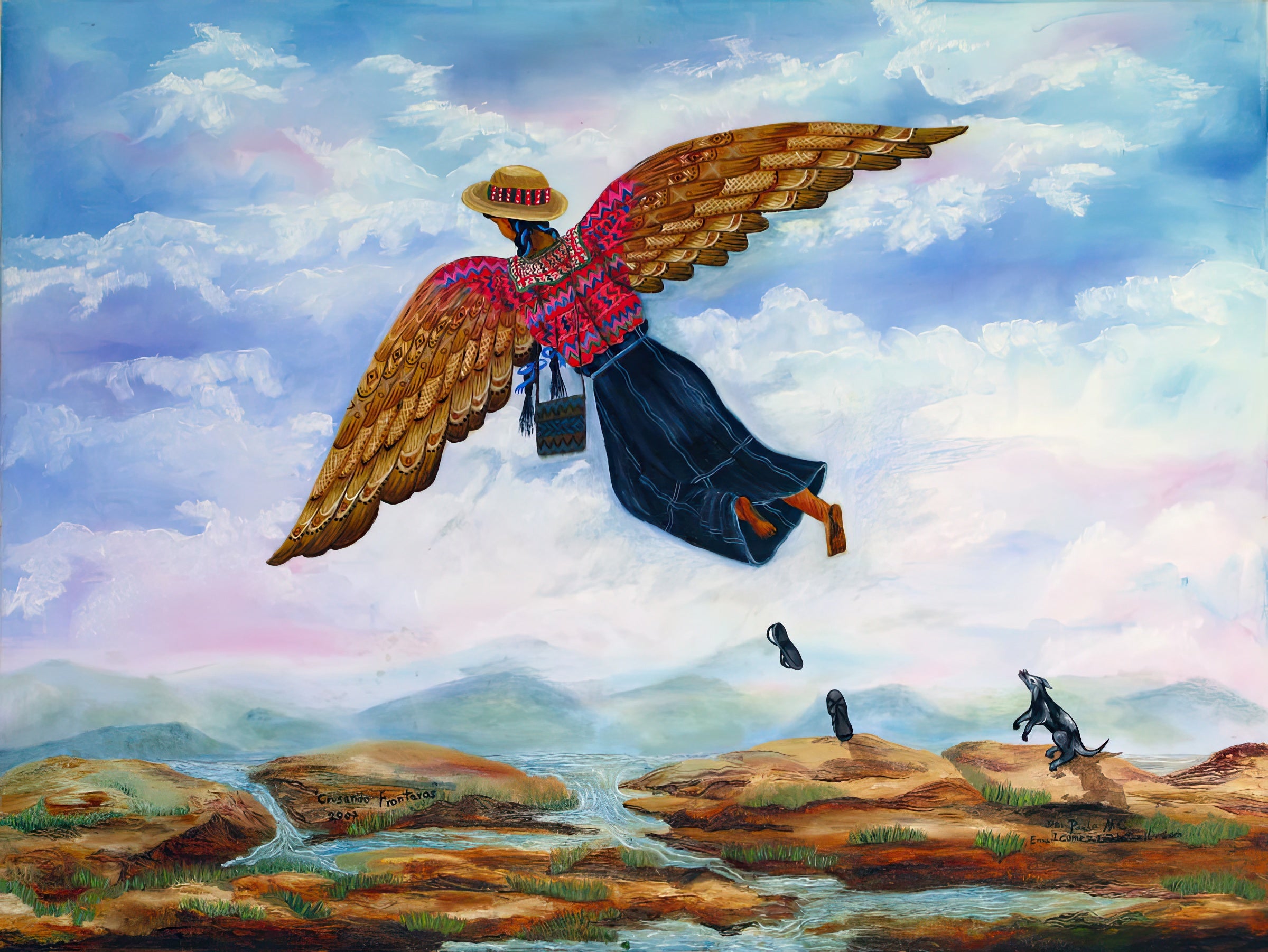
Paula Nicho Cúmez (Maya Kaqchikel), originally from San Juan Comalapa (Chixot in Kaqchikel), Guatemala, inherited the art of weaving from her mother and eight sisters. Though she didn’t realize it at the time, as she warped and wove the threads, her path in the artistic world had already begun. One day, her grandfather, a second-generation apprentice to the first Chixot painter, told her, “The weaving you do is beautiful, but it is a laborious art.” Nicho and her sisters didn’t understand; for them, weaving was just an activity. Their grandfather, in addition to being a painter, was a designer of the community’s Easter carpets, which are handmade with custom-dyed sawdust or sand. When he saw the talent Nicho had for weaving, he said to her, “Why don’t you look for another medium besides weaving?”
Nicho didn’t become a painter as a child because painting was not common among women, but her grandfather’s comments planted the seed. Years later, Nicho married her husband Salvador, a painter, and he would water the seed that Nicho’s grandfather had planted in her. “Why don’t you pick up some brushes?” he suggested. “I encourage you to try to express yourself in this beautiful art! You can do many things because your weavings are beautiful, but in painting, it’s a whole other world.” Having the support of her grandfather and husband furthered Nicho’s desire to become a painter. “I thank God they were not sexist. There are many men who think that if you get married, you should only look after your family and take care of your husband. But both my husband and grandpa were open minded. I am very happy with my family,” she says.
Nicho says that even with her family’s support, the road to being recognized as a painter was difficult. When she started painting she formed a group with five other women, and the group received an invitation from UNESCO to present their paintings at a public event. Their ideas were original and unique as they aimed to express their own feelings and thoughts. The goal was not to copy the designs of the male painters of the community, and because of this, they received all kinds of feedback. Some said that their work was crazy and did not make sense, but others admired it. That is how Nicho and the other women came to call themselves surrealist Indigenous women painters of Guatemala.
Once, an art critic told them that surrealism was not from Guatemala, and said that “you should paint things proper to your country; you should change your name.” On another occasion, a different art critic showed up. He sought out Nicho and her group in Chixot, but some of the male painters in the community told the art critic that Nicho and her group were not from Comalapa, and that they were from a far away village. “But that wasn’t true,” says Nicho. “We live in the same village as them.” So when Nicho and the other women painters opened a small gallery, they decided to call themselves “Kaqchikel Women Painters of Comalapa’’ to show that they, too, could dedicate themselves to art in their community.
 “Mi Segunda Piel (My Second Skin)” by Paula Nicho, 2004.
“Mi Segunda Piel (My Second Skin)” by Paula Nicho, 2004.
Both Nicho’s painting and her painting style are in her blood. “I always dreamed of flying, and I had never had the opportunity to talk to my grandparents or consult a professional about the meaning of my dreams. One day, a psychologist saw my exhibition and sought me out to talk to me about what she saw in my paintings. She said, ‘I congratulate you. I know that someday your paintings will fly, and you, too, will fly to show your paintings.’ That gave me a lot of joy and inspiration,” says Nicho.
Since that encounter, Nicho gave free rein to her creativity and began painting many women, inspired by the sacrifice they make and how each one’s life unfolds. “Women wash, cook, take care of the family, take care of the food, and many more things. They are a source of inspiration,” she says, mentioning that one of the women she admires is Rosalina Tuyuc, a well-known Guatemalan human rights activist, with whom she has had the opportunity to talk. “I believe that we as women are capable of doing many things if we have the support of our family.”
In addition to her Indigenous identity and her identity as a woman, Nicho’s paintings have recurring themes such as the weight of history and nature. At times she has struggled to paint what she wants and to achieve recognition. “It wasn’t always easy. Sometimes I despaired, but art experts valued my work. When you travel, you find good friendships, both men and women,” she says. On her first international trip, Nicho met a collector from San Francisco. “We had the opportunity to bring 60 works and he started working with me. He makes promotional material with my art—cards and calendars, among other things. He has a very special eye. He told me that my style was magical realism because my paintings mix the day-to-day with the fantasy that comes from my imagination.
 “Mas Allá del Universo (Beyond the Universe)” by Paula Nicho, 2005.
“Mas Allá del Universo (Beyond the Universe)” by Paula Nicho, 2005.
“Some women who have married have left their art half-finished. Others no longer want to paint because people don’t want to pay the price of paintings, and creating art is an investment. In Guatemala, most people don’t appreciate art. Still, I say that art has given me life. When I look back on my travel experiences, they seem like unforgettable dreams. I had the opportunity to make a trip to the opening of a Smithsonian Museum of the American Indian in the United States. I took a very special painting with me called “My Second Skin.” I made it because when I was little, there was no freedom to wear our traditional clothing. My mother made me a güipil (Indigenous blouse) from Comalapa and told me, ‘when you participate at the school parade, you will wear this. No one will have a dress like yours.’ But at school, they told us all to wear the same blouse and skirts. It was a sad experience because I dressed in my traditional clothing and my mother went to Youth delegates from Rapa Nui. school with me. When the principal saw me like that, she said, ‘¡ixta!’ (you spoiled child!) My mother told me, ‘that’s how those people are, if you don’t improve this year at school, you’ll have to repeat the grade. Let’s go, you’re not going to participate in the parade.’ I remember the pain on my mother’s face, about to cry, and when we returned home she hugged me. I painted a woman who has figures on her skin because I believe that my clothing has value, and no one will tell me that it is useless. I feel that my clothing is like my second skin.
“Participating in that event at the Smithsonian was beautiful because we were also present during a march. Many Indigenous people came from different places. It was a huge event with people wearing all kinds of clothes. Experiences like that gave me the courage to continue painting what I wanted, what our grandparents have taught us. I believe that weaving is a way of healing, and painting works the same way. Making a work of art is inspiration put on canvas. The art I create represents Indigenous Peoples. My heart feels that we are not just a handful of people; there are many Indigenous people in the world.”
On her plans for the future and her art, Nicho says, “We still have a long way to go, but one of my projects with my daughters is to create my own website to make my paintings and theirs known.” She says she also wants to devote more time to her small art supplies store in town and expand it, since being in a small space does not allow her to feel totally free. Another long-term dream is to open a school to share her knowledge. And now that her children are grown, she has more time to paint.
Photos courtesy of Paula Nicho.
